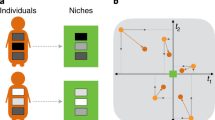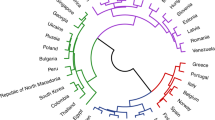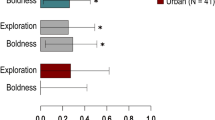Abstract
Regional differences in personality are associated with a range of consequential outcomes. But which factors are responsible for these differences? Frontier settlement theory suggests that physical topography is a crucial factor shaping the psychological landscape of regions. Hence, we investigated whether topography is associated with regional variation in personality across the United States (n = 3,387,014). Consistent with frontier settlement theory, results from multilevel modelling revealed that mountainous areas were lower on agreeableness, extraversion, neuroticism and conscientiousness but higher on openness to experience. Conditional random forest algorithms confirmed mountainousness as a meaningful predictor of personality when tested against a conservative set of controls. East–west comparisons highlighted potential differences between ecological (driven by physical features) and sociocultural (driven by social norms) effects of mountainous terrain.
This is a preview of subscription content, access via your institution
Access options
Access Nature and 54 other Nature Portfolio journals
Get Nature+, our best-value online-access subscription
$29.99 / 30 days
cancel any time
Subscribe to this journal
Receive 12 digital issues and online access to articles
$119.00 per year
only $9.92 per issue
Buy this article
- Purchase on Springer Link
- Instant access to full article PDF
Prices may be subject to local taxes which are calculated during checkout




Similar content being viewed by others
Data availability
The data that support the findings of this study are available from the corresponding author upon request. The personality data from the Gosling–Potter Internet Personality Project are propriety data and may not currently be shared publicly. To enquire about access to these proprietary data, please contact S.D.G. (samg@austin.utexas.edu). The mountainousness measure (based on standard deviation in elevation across a 20-/50-mile radius from one’s ZIP code of living) was developed by the research team, extracting topographical information from satellite images and geocoordinates. As such, a dataset containing the three mountainousness measures for the United States, as well as corresponding code, are available on our project page on the OSF (https://osf.io/y2mdw/). The sociodemographic ZIP code-level data are freely available from the United States Census Bureau and can be publicly accessed (https://www.census.gov/programs-surveys/acs).
Code availability
The analysis scripts are available as R code and SPSS syntax files on our OSF project page (https://osf.io/y2mdw/).
References
Borhani, N. E. Changes and geographic distribution of mortality from cerebrovascular disease. Am. J. Public Health 55, 673–681 (1965).
Levine, R. et al. Helping in 36 U.S. cities. J. Personal. Soc. Psychol. 67, 69–82 (1994).
McCann, S. J. H. Societal threat, authoritarianism, conservatism, and U.S. state death penalty sentencing (1977–2004). J. Personal. Soc. Psychol. 94, 913–923 (2008).
Oishi, S. Socioecological psychology. Annu. Rev. Psychol. 65, 581–609 (2014).
Rentfrow, P. J. & Jokela, M. Geographical psychology: the spatial organization of psychological phenomena. Curr. Dir. Psychol. Sci. 25, 393–398 (2016).
Camperio Ciani, A. S. & Capiluppi, C. Gene flow by selective emigration as a possible cause for personality differences between small islands and mainland populations. Eur. J. Personal. 25, 53–64 (2011).
Kitayama, S. et al. Voluntary settlement and the spirit of independence: evidence from Japan’s “northern frontier”. J. Personal. Soc. Psychol. 91, 369–384 (2006).
Rentfrow, P. J. et al. A theory of the emergence, persistence, and expression of geographic variation in psychological characteristics. Perspect. Psychol. Sci. 3, 339–369 (2008).
Rentfrow, P. J. et al. Regional personality differences in Great Britain. PLoS ONE 10, e0122245 (2015).
Harrington, J. R. & Gelfand, M. J. Tightness–looseness across the 50 United States. Proc. Natl Acad. Sci. USA 111, 7990–7995 (2014).
Obschonka, M. et al. In the shadow of coal: how large-scale industries contributed to present-day regional differences in personality and well-being. J. Personal. Soc. Psychol. 115, 903–927 (2018).
Rentfrow, P. J. et al. Divided we stand: three psychological regions of the United States and their political, economic, social, and health correlates. J. Personal. Soc. Psychol. 105, 996–1012 (2013).
Mõttus, R. et al. Personality traits below facets: the consensual validity, longitudinal stability, heritability, and utility of personality nuances. J. Personal. Soc. Psychol. 112, 474–490 (2017).
McCrae, R. R. & John, O. P. An introduction to the Five-Factor Model and its applications. J. Pers. 60, 175–215 (1992).
John, O. P. & Srivastava, S. in Handbook of Personality: Theory and Research Vol. 2 (eds Pervin, L. A. & John, O. P.) 102–138 (Guilford Press, 1999).
van de Vliert, E. Climato-economic habitats support patterns of human needs, stresses, and freedoms. Behav. Brain Sci. 36, 465–480 (2013).
Wei, W. et al. Regional ambient temperature is associated with human personality. Nat. Hum. Behav. 1, 890–895 (2017).
Uskul, A. K. et al. Ecocultural basis of cognition: farmers and fishermen are more holistic than herders. Proc. Natl Acad. Sci. USA 105, 8552–8556 (2008).
Talhelm, T. et al. Large-scale psychological differences within China explained by rice versus wheat agriculture. Science 344, 603–608 (2014).
Fincher, C. L. et al. Pathogen prevalence predicts human cross-cultural variability in individualism/collectivism. Proc. R. Soc. B 275, 1279–1285 (2008).
Jokela, M. Personality predicts migration within and between U.S. states. J. Res. Personal. 43, 79–83 (2009).
Kitayama, S. et al. Ethos of independence across regions in the United States: the production-adoption model of cultural change. Am. Psychol. 65, 559–574 (2010).
Conway, L. G. et al. in Geographical Psychology (ed. Rentfrow, P. J.) 31–50 (American Psychological Association, 2014).
Olsson, O. & Paik, C. Long-run cultural divergence: evidence from the Neolithic Revolution. J. Dev. Econ. 122, 197–213 (2016).
Sng, O. et al. The behavioral ecology of cultural psychological variation. Psychol. Rev. 125, 714–743 (2018).
Plaut, V. C. et al. Place matters: consensual features and regional variation in American well-being and self. J. Personal. Soc. Psychol. 83, 160–184 (2002).
Varnum, M. E. W. & Kitayama, S. What’s in a name? Popular names are less common on frontiers. Psychol. Sci. 22, 176–183 (2011).
Feng, J. et al. Ongoing voluntary settlement and independent agency: evidence from China. Front. Psychol. 8, 1287 (2017).
Ishii, K. Consequences of voluntary settlement: normative beliefs related to independence in Hokkaido. J. Cogn. Cult. 14, 159–169 (2014).
Vandello, J. A. & Cohen, D. Patterns of individualism and collectivism across the United States. J. Personal. Soc. Psychol. 77, 279–292 (1999).
Dollinger, S. J. et al. Individuality and relatedness of the self: an autophotographic study. J. Personal. Soc. Psychol. 71, 1268–1278 (1996).
Grimm, S. D. et al. Self-described traits, values, and moods associated with individualism and collectivism. J. Cross Cult. Psychol. 30, 466–500 (1999).
Realo, A. et al. The hierarchical structure of collectivism. J. Res. Personal. 31, 93–116 (1997).
Moorman, R. H. & Blakely, G. L. Individualism-collectivism as an individual difference predictor of organizational citizenship behavior. J. Organ. Behav. 16, 127–142 (1995).
Oishi, S. et al. Personality and geography: introverts prefer mountains. J. Res. Personal. 58, 55–68 (2015).
Triandis, H. C. et al. Individualism and collectivism: cross-cultural perspectives on self-ingroup relationships. J. Personal. Soc. Psychol. 54, 323–338 (1988).
Arpaci, I. et al. The relationship among individual differences in individualism-collectivism, extraversion, and self-presentation. Pers. Individ. Dif. 121, 89–92 (2018).
Conway, L. G. et al. Ecological origins of freedom: pathogens, heat stress, and frontier topography predict more vertical but less horizontal governmental restriction. Personal. Soc. Psychol. Bull. 43, 1378–1398 (2017).
Conway, L. G. et al. Socio-ecological influences on political ideology. Curr. Opin. Psychol. 32, 76–80 (2020).
Rentfrow, P. J. Statewide differences in personality: toward a psychological geography of the United States. Am. Psychol. 65, 548–558 (2010).
Nodregio. Mountain Areas in Europe: Analysis of Mountain Areas in EU Member States, Acceding and Other European Countries. European Commission contract No 2002.CE.16.0.AT.136 (2004).
Rapino, M. A. & Fields, A. K. Mega Commuters in the U.S.: Time and Distance in Defining the Long Commute Using the American Community Survey. Working Paper 2013-03 (United States Census Bureau, 2013).
Nezlek, J. in Cross-cultural Research Methods in Psychology (eds Matsumoto, D. & Van de Vijver, F.) 299–345 (Cambridge Univ. Press, 2010).
Fulmer, C. A. et al. On “feeling right” in cultural contexts. Psychol. Sci. 21, 1563–1569 (2010).
Götz, F. M. et al. Regional cultures and the psychological geography of Switzerland: person–environment–fit in personality predicts subjective wellbeing. Front. Psychol. https://doi.org/10.3389/fpsyg.2018.00517 (2018).
Bleidorn, W. et al. To live among like-minded others: exploring the links between person-city personality fit and self-esteem. Psychol. Sci. 27, 419–427 (2016).
Hemphill, J. F. Interpreting the magnitudes of correlation coefficients. Am. Psychol. 58, 78–79 (2003).
Strobl, C. et al. An introduction to recursive partitioning: rationale, application, and characteristics of classification and regression trees, bagging, and random forests. Psychol. Methods 14, 323–348 (2009).
Ebert, T., Götz, F. M., Gladstone, J. J., Müller, S. R., & Matz, S. C. Spending reflects not only who we are but also who we are around: The joint effects of individual and geographic personality on consumption. J. Personal. Soc. Psychol. https://doi.org/10.1037/pspp0000344 (2020).
IJzerman, H. et al. The human penguin project: climate, social integration, and core body temperature. Collabra Psychol. 4, 37 (2018).
Steiger, J. H. Tests for comparing elements of a correlation matrix. Psychol. Bull. 87, 245–251 (1980).
Rentfrow, P. J. & Jokela, M. in The Praeger Handbook of Personality Across Cultures (ed. Church, T.) 225–250 (Praeger Publishing, 2017).
DeYoung, C. G. et al. Between facets and domains: 10 aspects of the Big Five. J. Personal. Soc. Psychol. 93, 880–896 (2007).
Hotard, S. R. et al. Interactive effects of extraversion, neuroticism, and social relationships on subjective well-being. J. Personal. Soc. Psychol. 57, 321–331 (1989).
Bogg, T. & Roberts, B. W. Conscientiousness and health-related behaviors: a meta-analysis of the leading behavioral contributors to mortality. Psychol. Bull. 130, 887–919 (2004).
Schoen, H. & Steinbrecher, M. Beyond total effects: exploring the interplay of personality and attitudes in affecting turnout in the 2009 German federal election. Polit. Psychol. 34, 533–552 (2013).
Uchida, Y. et al. Farming cultivates a community-level shared culture through collective activities: examining contextual effects with multilevel analyses. J. Personal. Soc. Psychol. 116, 1–14 (2019).
Obschonka, M. et al. Did strategic bombing in the second world war lead to “German Angst”: a large-scale empirical test across 89 German cities. Eur. J. Personal. 31, 234–257 (2017).
Funder, D. C. & Ozer, D. J. Evaluating effect size in psychological research: sense and nonsense. Adv. Methods Pract. Psychol. Sci. 2, 156–168 (2019).
Gladstone, J. J. et al. Can psychological traits be inferred from spending? Evidence from transaction data. Psychol. Sci. 30, 1087–1096 (2019).
Cialdini, R. B. We have to break up. Perspect. Psychol. Sci. 4, 5–6 (2009).
Maner, J. K. Into the wild: field research can increase both replicability and real-world impact. J. Exp. Soc. Psychol. 66, 100–106 (2016).
Oishi, S. & Graham, J. Social ecology: lost and found in psychological science. Perspect. Psychol. Sci. 5, 356–377 (2010).
Mackay, T. F. C. et al. The genetics of quantitative traits: challenges and prospects. Nat. Rev. Genet. 10, 565–577 (2009).
Plomin, R. Genetics and general cognitive ability. Nature 402, 25–29 (1999).
Plomin, R. et al. The genetic basis of complex human behaviors. Science 264, 1733–1739 (1994).
Smith-Woolley, E. et al. Polygenic score for educational attainment captures DNA variants shared between personality traits and educational achievement. J. Personal. Soc. Psychol. 117, 1145–1163 (2019).
Okbay, A. Genome-wide association study identifies 74 loci associated with educational attainment. Nature 533, 539–542 (2016).
Adjerid, I. & Kelley, K. Big data in psychology: a framework for research advancement. Am. Psychol. 73, 899–917 (2018).
Chen, E. E. & Wojcik, S. P. A practical guide to big data research in psychology. Psychol. Methods 21, 458–474 (2016).
Kosinski, M. et al. Facebook as a research tool for the social sciences: opportunities, challenges, ethical considerations, and practical guidelines. Am. Psychol. 70, 543–556 (2015).
Miller, D. I. When do growth mindset interventions work? Trends Cogn. Sci. 23, 910–912 (2019).
Abelson, R. P. A variance explanation paradox: when a little is a lot. Psychol. Bull. 97, 129–133 (1985).
Bond, R. M. et al. A 61-million-person experiment in social influence and political mobilization. Nature 489, 295–298 (2012).
Matz, S. C. et al. In a world of big data, small effects can still matter: a reply to Boyce, Daly, Hounkpatin, and Wood (2017). Psychol. Sci. 28, 547–550 (2017).
Noftle, E. E. & Robins, R. W. Personality predictors of academic outcomes: big five correlates of GPA and SAT scores. J. Personal. Soc. Psychol. 93, 116–130 (2007).
Prentice, D. A. & Miller, D. T. When small effects are impressive. Psychol. Bull. 112, 160–164 (1992).
Ozer, D. J. & Benet-Martínez, V. Personality and the prediction of consequential outcomes. Annu. Rev. Psychol. 57, 401–421 (2006).
Roberts, B. W. et al. The power of personality: the comparative validity of personality traits, socioeconomic status, and cognitive ability for predicting important life outcomes. Perspect. Psychol. Sci. 2, 313–345 (2007).
Soto, C. J. How replicable are links between personality traits and consequential life outcomes? The life outcomes of personality replication project. Psychol. Sci. 30, 711–727 (2019).
Lu, J. G. et al. Polluted morality: air pollution predicts criminal activity and unethical behavior. Psychol. Sci. 29, 340–355 (2018).
Rogers, K. H. & Wood, D. Accuracy of United States regional personality stereotypes. J. Res. Personal. 44, 704–713 (2010).
Costa, P. T. Jr. & McCrae, R. R. Domains and facets: hierarchical personality assessment using the revised NEO personality inventory. J. Personal. Assess. 64, 21–50 (1995).
Soto, C. J. & John, O. P. The next Big Five Inventory (BFI-2): developing and assessing a hierarchical model with 15 facets to enhance bandwidth, fidelity, and predictive power. J. Personal. Soc. Psychol. 113, 117–143 (2017).
Gosling, S. D. et al. Should we trust web-based studies? A comparative analysis of six preconceptions about Internet questionnaires. Am. Psychol. 59, 93–104 (2004).
United States Census Bureau. Quick Facts United States https://www.census.gov/quickfacts/fact/table/US/PST045218 (2018).
United States Census Bureau. American Community Survey (2006–2010) https://www.census.gov/programs-surveys/acs/news/data-releases.2010.html (2011).
United States Census Bureau. 2010 Census Data Products: United States https://www.census.gov/population/www/cen2010/glance/ (2011).
Ebner-Priemer, U. W. et al. Analytic strategies for understanding affective (in)stability and other dynamic processes in psychopathology. J. Abnorm. Psychol. 118, 195–202 (2009).
Jahng, S. et al. Analysis of affective instability in ecological momentary assessment: indices using successive difference and group comparison via multilevel modeling. Psychol. Methods 13, 354–375 (2008).
United States Census Bureau. Median Center of Population for the United States: 1880 to 2010 https://www2.census.gov/geo/pdfs/reference/cenpop2010/centerpop_median2010.pdf (2010).
van de Vliert, E. & Van Lange, P. A. M. Latitudinal psychology: an ecological perspective on creativity, aggression, happiness, and beyond. Perspect. Psychol. Sci. 14, 860–884 (2019).
Janitza, S. et al. Random forest for ordinal responses: prediction and variable selection. Comput. Stat. Data Anal. 96, 57–73 (2016).
Acknowledgements
The present research was supported by doctoral scholarships of the Economic and Social Research Council and the Cambridge Trust to F.M.G. We thank S. Volsa (Karl-Landsteiner University of Health Sciences, Austria) for assistance with visualization of our mountainousness measure, and A. Gvirtz (University of Cambridge, UK) for aesthetic and moral support. We also thank A. Nehrlich (University of Koblenz-Landau, Germany) for kindly allowing us to run some of the more computationally heavy analyses remotely. The funders had no role in study design, data collection and analysis, decision to publish or preparation of the manuscript.
Author information
Authors and Affiliations
Contributions
F.M.G. and S.S. conceived the core research idea and designed the study. S.D.G. and J.P. collected and preprocessed the data from the Gosling–Potter Internet Personality Project. S.S. developed the mountainousness measure and collected the corresponding topographical information. F.M.G. analysed the data. F.M.G., S.D.G. and P.J.R. wrote the manuscript. S.S. contributed to interpretation of the results and provided critical revisions. All authors approved the final version of this manuscript.
Corresponding authors
Ethics declarations
Competing interests
The authors declare no competing interests.
Additional information
Peer review information Primary Handling Editor: Aisha Bradshaw.
Publisher’s note Springer Nature remains neutral with regard to jurisdictional claims in published maps and institutional affiliations.
Supplementary information
Supplementary Information
Supplementary Methods, Supplementary Tables 1–13 and Supplementary References.
Rights and permissions
About this article
Cite this article
Götz, F.M., Stieger, S., Gosling, S.D. et al. Physical topography is associated with human personality. Nat Hum Behav 4, 1135–1144 (2020). https://doi.org/10.1038/s41562-020-0930-x
Received:
Accepted:
Published:
Issue Date:
DOI: https://doi.org/10.1038/s41562-020-0930-x
This article is cited by
-
Does Inequality Shape Human Character? Cross-Cultural Associations between Character Strengths and the Gini Index in 68 Countries
Journal of Happiness Studies (2024)
-
Subjective socioeconomic status and income inequality are associated with self-reported morality across 67 countries
Nature Communications (2023)
-
ecolo-zip: A global, rich and granular characterization of biogeophysical ecology for 1.5 million postal codes
Scientific Data (2023)
-
Disparate impacts on online information access during the Covid-19 pandemic
Nature Communications (2022)
-
Registered report: Social face evaluation: ethnicity-specific differences in the judgement of trustworthiness of faces and facial parts
Scientific Reports (2022)



